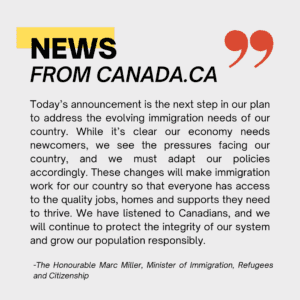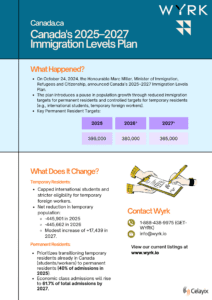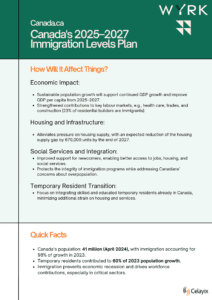How Immigration Policies are Reshaping Hourly Jobs
Between 2020 and 2024, Canada experienced a dramatic demographic transformation spurred by increasing immigration and changing workforce dynamics. This shift, driven by rising numbers of international students, permanent residents, and temporary foreign workers (TFWs), is redefining labor across critical industries. Evolving immigration policies have further shaped this landscape, influencing how businesses adapt to workforce availability and regulatory compliance.
The Rise of International Students
Post-pandemic, international students have become vital contributors to Canada’s labor force. As educational institutions adapted to online and hybrid learning, enrollment surged, and campuses began to brim with cultural diversity. By 2025, international students are projected to fill critical part-time and shift work roles in hospitality, retail, and healthcare. These students enhance workplace inclusivity and address labor gaps during peak business hours.
Permanent Residents Bolstering the Workforce
Canada’s immigration policies have prioritized pathways to permanent residency for skilled workers and their families, adding long-term stability to the labor market. Urban centers, particularly, are witnessing an economic boost as immigrants settle and integrate. Industries like healthcare and hospitality, which face acute labor shortages, benefit significantly from this influx. By 2025, permanent residents are expected to constitute a larger share of skilled labor, driving diversity and economic growth.
The Evolving Role of Temporary Foreign Workers (TFWs)
TFWs are a cornerstone of Canada’s labor strategy, especially in sectors requiring seasonal or flexible labor, such as agriculture, construction, and hospitality. As the gig economy expands, many TFWs are stepping into part-time roles that keep businesses operational during high-demand periods. However, the program’s challenges—including exploitation and limited worker mobility—highlight the need for ongoing reforms to ensure fairness and sustainability.
The Impact of TFW Program Changes in 2024 on HR and Workforce Management
In 2024, Canada implemented significant changes to its Temporary Foreign Worker (TFW) program, bringing new challenges for HR professionals and workforce management across industries. These policy shifts are reshaping how businesses hire and retain talent, especially in sectors traditionally reliant on foreign labor.
Critical Changes to the TFW Program
- Labour Market Impact Assessment (LMIA) Restrictions: LMIAs for low-wage positions are no longer processed in regions with unemployment rates of 6% or higher. This targets agriculture, hospitality, and manufacturing industries, which often depend on TFWs for seasonal and low-wage jobs.
- Reduced TFW Workforce Caps: Employers can now only hire 10% of their workforce through the TFW program, down from the previous 20% cap. This limits businesses’ ability to rely on foreign workers, particularly in industries facing persistent labor shortages.
- Shortened Work Duration: TFWs in low-wage positions can work for only one year, which is reduced from two. This change exacerbates turnover challenges, demanding more frequent recruitment and onboarding efforts.
Challenges for HR and Workforce Management
These changes introduce substantial implications for HR teams, particularly in hiring, retention, and compliance:
Increased Recruitment Pressure:
With stricter caps and shorter employment durations, HR professionals must prioritize hiring and retaining Canadian workers. This includes crafting competitive compensation packages, improving workplace conditions, and creating upskilling programs to attract local talent.
Elevated Focus on Workforce Planning:
The reduced reliance on TFWs necessitates robust workforce planning strategies to address seasonal labor needs and mitigate the risk of understaffing. Industries with cyclical demand, like hospitality and agriculture, must adopt predictive workforce scheduling tools to balance operational requirements with limited labor availability. By proactively addressing these challenges, businesses can ensure operational continuity and maintain workforce stability.
Greater Compliance Burden:
Employers must navigate new regulations carefully to avoid penalties. HR teams will need to document hiring processes meticulously, demonstrating efforts to hire Canadian workers before seeking LMIAs. These policies demand more rigorous labor market assessments and transparent HR processes.
Turnover Management:
The one-year work term limit for TFWs increases the frequency of turnover. HR teams must streamline onboarding and offboarding processes, develop effective knowledge transfer strategies, and focus on retaining institutional expertise within the organization.
Opportunities for HR Innovation
While these changes create challenges, they also present opportunities for HR leaders to reimagine their approach to workforce management:
Upskilling and Reskilling:
Investing in training programs to elevate the skills of Canadian workers can help address labor shortages and build a more sustainable talent pipeline. This aligns with government priorities and positions companies as attractive employers.
Technology Integration:
Tools like workforce management software can optimize scheduling, track labor trends, and ensure compliance with labor laws. Leveraging such technology helps mitigate disruptions caused by staffing limitations and ensures operational efficiency.
Improved Employee Experience:
Addressing retention issues involves fostering a workplace culture that values employee well-being. Flexible schedules, competitive wages, and robust HR support systems will be crucial in reducing turnover and building loyalty among Canadian workers.
Broader Implications for Workforce Dynamics
The revised TFW program reflects a broader shift in Canadian labor and immigration policies, prioritizing domestic employment opportunities over-reliance on foreign labor. This aligns with ongoing discussions about labor equity, worker rights, and economic resilience.
For businesses, the message is clear: reliance on TFWs must be supplemented with proactive investment in local talent development. The HR function is at the forefront of this transformation, ensuring compliance, driving innovation, and maintaining workforce stability amid changing regulations.
This blog is written with the assistance of Wyrk.io, a platform dedicated to connecting businesses with individuals looking to pick up flexible shifts in the security and hospitality industries across BC, Canada. While this article is not sponsored, Wyrk.io is a fantastic resource for companies aiming to fill critical staffing gaps and for workers seeking flexible opportunities.
To learn more about how Wyrk.io can help your business or career, feel free to contact them at:
Email: info@wyrk.io
Phone: 1-888-438-9975 (GET-WYRK)








